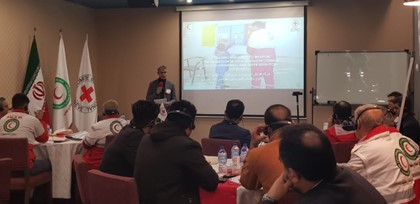Iran is impacted by the effects of weapons contamination, like mines and Explosive Remnants of War (ERW) because of the Iran-Iraq war during the 1980’s in five western provinces of West Azarbaijan, Ilam, Kurdistan, Kermanshah, and Khuzestan. Demining operations have been undertaken by the Iranian authorities for many years which has reduced the volume of contamination, however, mines and ERWs still pose significant threats to the civilian populations in those areas where they need to cross the contaminated land to access water or agricultural fields or to make a living. The Nomad tribes and their animals that cross those areas are also at risk of accidents.
Moreover, Afghanistan, the eastern neighbor of Iran is affected by a protracted conflict and in many areas contaminated by mines and ERWs. This poses risks to the Afghan migrants who cross the border of Iran and Afghanistan.
Aiming at limiting the threats posed to civilians through the Mine Risk Education (MRE) program and provision of physical rehabilitation services to the victims to alleviate their suffering, the ICRC in cooperation with its partners Iranian Red Crescent Society (IRCS), Iranian Mine Action Center(IRMAC), Janbazan Medical and Engineering Research Centre, State Welfare Organization and Maaf Institute addressed the consequence of Iran-Iraq war resulted in huge mine/ERW contamination.
The ICRC and the IRCS have been cooperating since 2004 in MRE project which aims to sensitize and educate the civilians living in or passing through the mine/ERW-contaminated areas about the risks and safe behaviors in encountering those hazards. The ICRC provides technical and financial support to the project that is carried out by the volunteers and staff of the IRCS branches in the affected provinces.
In addition, the ICRC supports the IRMAC as the national mine action coordinator body in the country in their mine action activities on victim assistance, MRE and technical training of mine actors. So far, the ICRC facilitated access of the IRMAC to medical kits and personal protective equipment to ensure the continuance of safe humanitarian demining activities.
Moreover, the ICRC has participated in the annual events that the IRMAC organizes to commemorate the International Day for Mine Awareness and Assistance in Mine Action days.
The ICRC supports the IRMAC with:
- Technical expertise
- Facilitating the flow of information/experience and knowledge through peer-to-peer exchange between the IRMAC and other mine action centers/actors abroad.

Risk Awareness and Safer Behavior (RASB) workshop, Tehran, 2023

Raising awareness session for children, Kordestan, 2022

Distributing stationary with the Risk Awareness messages among students, Kourdistan, 2021

International Roundtable on “Humanitarian Mine Action, Challenges and Best Practices”, Tehran, 2019

ICRC Mine Risk Education Project in Iran, Kermanshah, 2018

